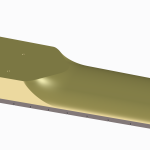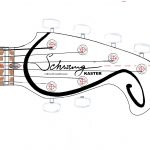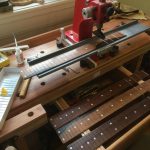Vision of designer Charles J. Janssen
Whenever I step into a guitar shop, I must admit that I don’t grab – let alone plug in and play – any of the unattractive guitars. And quite a few guitars just do not look appealing. It’s a shame, really, because it’s not about looks, is it? A guitar needs excellent playability and a characteristic, expressive sound. Clear intonation and stable tuning. Not many instruments on the market meet my high standards and have a tasteful appearance. If they do, they break the bank. Searching for the holy grail is like walking into a swamp of marketing hogwash. What matters in an electric guitar, is functional and ergonomic design, quality of components and professional finishing and setup. And yes, esthetics. For that reason, I put a lot of time and effort in product development, selection of materials, assembly and finish of my guitars. Design, time and care. That’s why they stand out. Here are some video's on how it's made:
In designing the Schwung Guitars, I maintained the tried and tested features of the iconic guitars of pop music. It’s a known fact that the characteristic sound of a Stratocaster, Tele, Les Paul or PRS is only acquired when all essential factors are combined. This means there’s no way around copying a little. But I do make use of a number of modern innovations to bring the quality to the highest level. On top of that, I offer many extras not found in other brands. Finally, Schwung Guitars offer an original and tasteful appearance. In short my recipe for an uncompromised top quality electric guitar: functional and ergonomic design, cad/cam and CNC accuracy, compound radius fretboard, stainless steel frets, all PLEK’d, resulting in superb playability. And while using well dried, sometimes decades old wood and high-end components only, this all results in great tone.
It all begins with a clever design. Some luthiers copy the proven brands. Because a lot of customers go for that. But when one values image above quality, I would suggest: buy a Fender, Gibson or PRS, new or vintage. I made a deliberate decision to go for refreshing looks, without losing track of the roots, authentic sounds and traditions of the electric guitar. After all, the Strat ergonomics don’t leave much room for improvement. I say not much, because we managed to come up with some quite noticeable features. The a-symmetrical shape of the neck, the compound radius, and the smoothly finished frets all contribute to a relaxed fretting hand. And on a Schwung Guitar, the volume knob is not too close to the bridge, like it is on a strat to my opinion, nor too far away like on a Gibson or PRS. It is just close enough to use it properly, even for volume swells while playing. Switches are positioned where you can easily reach them. And again, with all respect, this is not the case on a Les Paul or PRS. And the jack input is on the front, where you can see it, so that the cable plug can be controlled in playing position. The Schwung can stand upright against the wall without tipping over. The 4-2 positions of the (locking) tuners are easier to adjust, because they have more space between them then the 6 on a row. The strings go straight over the nut and because of the variabel hights of the string posts the angle of the strings on the nut is optimal. That is why no string retainers are necessary. This all contributes to tuning stability. The Schwung is perfectly balanced, on your lap, as well as when standing up right. (As is the Strat, but not the Les Paul.) The a-symmetric neck, compound radius and smooth rounded stainless steel frets are also substantial design improvements. Steel frets provide better sound, more sustain and long lasting durability, preventing an expensive refretting.
Schwung offers three different models, two different scales and a multi scale, and several wood and color combinations. We have seven pickguard designs in many different colors. All pickup configurations, as well as several bridges are possible. An N-tune on-board tuner is optional. And last but not least, we offer a Schwung custom Guitar, which is fully customized to your preferences. The endless combination possibilities make each Schwung guitar unique and a true jewel to look at. Different, but not too different. In short, a fantastic and affordable alternative to the best of A-brands.
Models
As mentioned above, you have a choice of three Schwung models: the KASTER (based on the Strat and/or Tele), the MAHOGANY (based on the Gibson solid body models), and the CROSSOVER (based on a more versatile concept like most PRS). A fourth model is the CUSTOM, which is built from scratch to your exact wishes. The many options in wood, PU's, scale, finish, pickguards and hardware enable you to have your very own, personal Schwung custom guitar. Read on, for explanation and recommendations.
The influence of guitar sounds in pop history
The development of the electric solid body guitar in the fifties was influenced by its predecessor, the (semi-) hollow body archtop. And these guitars sprung from the acoustic (jazz) guitars of the era. The electric guitars that were developed in the nineteen fifties had a relatively short scale. Especially the Gibsons. In those days, guitars were mostly played in a clean way, on fat, rigid strings. Fender offered the Broadcaster (in fact the first Telecaster), featuring a longer 25.5 inch (648 mm) scale. Fender used Swamp Ash and later Red American Alder for the bodies, and Maple for the neck, for economic and practical reasons, but this embossed the Fender sound until now. Like the choice for Mahogany embossed the character of the Gibson sound until now.
The fret radius available on the first electric ‘solid body’ guitars was 7.25 inch, as designed by Leo Fender. This works comfortably well for the first positions, but modern playing requires a less arched fretboard, to prevent the strings from buzzing when bending them at the higher positions up the neck. That’s why Fender now produces the less radiused 9.5 inch fretboards. Also, the slightly longer Fender scale (compared to Gibson’s) enhances string flexibility and therefore playing comfort, according to many guitarists, but also creates a slightly different tone. With a longer scale it is possible to use thicker strings with more mass, in a lower tuning or drop D tuning, which results in sounds that move towards the baritone models. (Baritone guitars have scales up to 29 inch, 73 cm.)
In any case, the combinations of wood, scale, radius, pickups and hardware found in those days have determined the authentic guitar sounds as we know them from pop history, also influenced of course by guitar heros like Jimmy Hendrix, Jimmy Page, Stevie Ray Vaughan, George Benson, Eddie Van Halen and many more. Sounds that are now engraved into our collective memories. In Schwung Guitars, I have tried to combine the characteristics of those iconic guitar sounds with innovations and a bright design. First and foremost, through ergonomics, playability and sound, but the eye needs to be pleased as well. Especially with the KASTER and MAHOGANY models, I have tried to meet the desire of those seeking for authentic tone.
Below, you will find the Schwung Guitar features, possibilities and qualities. Also check out ‘Configure your Schwung’.
Scale
Schwung Guitars offers two different scale lengths: a relatively short 25.25 inch (641 mm) scale, which is still longer than a Gibson and a PRS, but shorter than a Fender, and a modern 25.65 inch (652 mm) scale, which is slightly longer than a Fender. The difference between the two is a mere 1.1 cm, but that is just enough to be felt and heard. All Schwung Guitars have 24 medium stainless steel frets (Ferdinant Wagner, Germany). Both scales feature a compound radius from 8 inch (at the nut) to 11 inch (at the 24th fret) to 13 inch at the bridge. This allows for optimal first position ergonomics and ideal modern playing at higher positions up the neck. The best of both worlds. My hands are fairly small, but I still prefer the 652 over the 641. But that’s just my personal preference. In any case, hand size is irrelevant to the scale size, unless it concerns young children. More important are playing style, ergonomics and comfort. And sound, of course. Preferences are very personal, but here are some recommendations:
- Choose a 25.65 inch (652 mm) scale if you are used to playing a Strat or a Tele (Fender 648 mm), or if you use Drop D or other lowered tunings, and/or if you prefer the typical Fender/country sound, or the metal and high gain sounds. Playability is excellent, because the strings feel slightly more flexible and comfortable (due to their length), and also there is a little more room at the higher positions, above the 20th fret. A pentatonic lick in A at the 17th position is no problem, because of the larger fret space and the good accessibility of the highest range of the neck, due to the cut-away body. This longer scale fits nicely to the Schwung KASTER, but a Strat style guitar could also be equipped with a shorter fret board.
- Choose a 25.25 inch (641 mm) scale if you are used to a more conventional scale (Gibson 625, PRS 638). It features a more average fret spacing and offers a good playability at lower positions. Since this 25.25 inch scale is still slightly longer than (for instance) a Gibson, up the neck playability is also substantially better, the highest frets being well accessible, due to the shape of the body. This shorter scale is a good match to the Schwung MAHOGANY, if you want to come close to a Les Paul or PRS sound. (Of course, the sound is largely determined by electronics, hardware, neck joint and wood, but a slightly shorter scale will help to achieve authentic Gibson and PRS resembling sounds.)
Fanned Frets
Schwung also offers a fanned fret option. This is a combination of both scales as mentioned above: for the low E string the longer scale, for the high e the shorter scale. The frets are now no longer orthogonal to the strings, except for the 9th fret, but in this way compensation is offered for differences between the 6 string gauges, string thickness and action. This enhances intonation significant, all along the neck, especially when chords are played together with open strings. Because the two scales differ only subtle, only 11 mm to be precise, one can easily get used to this fretboard, within minutes really. Disadvantage though is that the PLEK-machine cannot handle fanned frets yet, unfortunately this technical improvement is not yet available. The aligning of the frets is in these cases done by hand, which is a hell of a job considering the hard steel. Nevertheless it is rewarding, since the improvement of the intonation proves really to be fantastic. That is why I certainly advise this option.
Neck and fretboards
De neck has a medium C profile, corresponding to most necks used in top notch custom brands. The neck is slightly a-symmetrical (as found on Stevie Ray Vaughan’s guitars). In my personal opinion (but also according to all players who tested my guitars) it offers optimal playing comfort and (in combination with the Stewmac truss rod) superb sound quality. The wood of the neck has more impact on the sound than the wood of the body, which speaks in favor of a heavier neck, with more mass, but in my opinion playing comfort should have the priority. Schwung Guitar neck shape is derived from some of my favorite guitars, which include a 1997 Fender CS relic Stratocaster (with a 9.5 inch radius, built by the legendary Vince Cunetto), a Gibson LP Standard (11 inch radius), a Custom PRS (10 inch) and my old favorite vintage Telecaster (7.25 inch radius). I calculated the average measurements of these guitars and used these as input for the cad/cam 3D drawings. The neck and fretboard, as well as the body, are guaranteed to be milled within 0.01 mm accuracy of the set specifications by means of the truly 3d programming used in the CNC production method. This also makes it easier to accurately realize the more complex compound radius of the fretboard. The radius of a Schwung fretboard goes from 8 inch on the nut to 11 on the 24th fret, to 13 on the bridge. Although the two scales hardly differ in radius, each fret was pressed into the fretboard with a separate aluminium inlay. This means that we first made 2 x 24 = 48 special aluminium inlays (also made with CNC precision) so that every fret could be pressed in with utmost accuracy, in the exact correct radius.
Wood
As stated above: if you want the typical, authentic Fender sound, there’s really no alternative for American Red Alder for the body and Maple for the neck. I generally opt for the Rosewood fretboard, because of its rich and complex sounds. But I do not exclude an all Maple neck or any other fretboard. In my view, if the wood for a fretboard is hard enough and it combines tonally with the woods of body and neck, all that really matters are the optical qualities. If you are looking for a Les Paul sound, the proper type of Mahogany is critical. I sometimes combine it with a very hard Ebony-like fretboard (depending on the PU configuration), obviously because of the sparkling treble it produces on top of the already warm sound of the Mahogany. For the CROSSOVER model, I often deliberately combine an Alder body with a Mahogany/Ebony neck, or sometimes even the other way around (Mahogany body/Maple neck), because this brings justice both to single coils and (split-)humbuckers. And as I said: for a fretboard the optical appearance, in relation to the guitar as a whole, is always a measure of quality as well. This brings the wood configurations of Schwung models down to:

Pickups
The electric guitar’s character and sound are determined by electronics, but also by wood and hardware. String energy must be transfered to the whole guitar because the resonance contributes to the tone. Some guitar builders claim that 70 % of the guitar’s character is determined by the PU’s and electronics, and only 30 % by the type of wood and hardware used. I believe its fifty-fifty. This is arguable, of course, but I do believe pickups are crucial. That’s why I select my pickups, potmeters and capacitators with the utmost care. The brands I use are all the famous brands on the market as well as some less known, but excellent pickups, from Korea and Japan. For my Schwung CROSSOVER I often choose the Seymour Duncan P-Rail, because of its versatile possibilities and great sound. It is switchable with a 3-way toggle from Single Coil use to P90 and to Humbucker. The humbucker can be wired in series (hot) or parallel (lower output).
These are my general recommendations (+ = recommended, – = not recommended) for pickups in combination with wood types:

Pickguard shape and color
A large part of Schwung Guitars esthetics results from the choice of the pickguard shape and colour. They are offered in seven shapes – the Delta, the Shark, the Coolchrome, the Elegance, the Pythagoras, the Windflow, and the Split – and in a range of colors. Obviously, the guitar should be shaped as a whole: the combination of pickguard with body finish, pickup covers, hardware and knobs should be in harmony. I will be happy to advise you.
All options, as well as an order- or pricing request, are summed up in ‘configure your Schwung’.




































